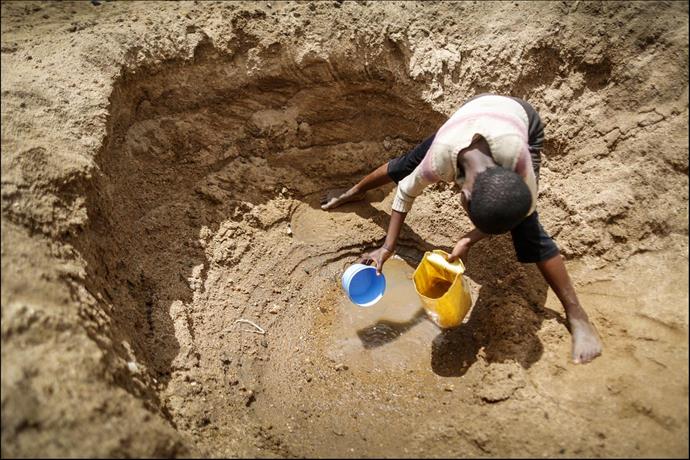
Why Kenya's seasonal rains keep failing and what needs to be done
Kenya's long rains – which typically run from March to May – haven't started in most of the country. Some regions have now experienced the failure of three rainy seasons in a row. At least 2.6 million people are experiencing crisis levels of food insecurity. Victor Ongoma shares his insights.
What's known about changing weather patterns in Kenya?
Kenya's weather patterns are changing . The change in rainfall patterns has a huge impact on Kenya because 98% of the country's agriculture is rain-fed. The major challenge that farmers face is timing. It's critical for them to know when rains start and stop so that they know when to plant or harvest their crops.
Most parts of Kenya experiences two rain seasons: March to May's 'long rains', and October to December's 'short rains'. The months of June to August are mainly cool and dry over most parts of the country except for some parts in the western region that report some rains. Hot and dry conditions are observed over the entire country in January and February. In recent years, the delay in rains has become a norm . And this is what we're seeing again now. In other years, the rains come on time but then stop earlier than anticipated. This leads to massive crop failures.
Other than rainfall patterns, studies show a reduction in the amount of rainfall, especially during the March to May 'long rains'. This is a worrying trend given that this is the main growing season.
What might be causing these changes?
The changes in Kenya's rainfall patterns have been linked to climate change. Global warming is known to cause an overall warming in the atmosphere and the ocean, resulting in complex shifts that affect our planet's weather and climate systems . Research shows that rainfall is reducing while temperature is on the increase with time over Kenya, as is the case in other countries in the Great Horn of Africa .
In the case of Kenya's delayed rains, another culprit has also been identified: cyclones. It's normal for cyclones to happen on the southern African coast from February to March. But their magnitude is dictated by sea surface temperatures. These are currently warming as a result of increased emission of greenhouse gases in the atmosphere, leading to global warming. This means the intensity and frequency of cyclones is likely to increase.
The most recent cyclone was Idai which occurred in the western Indian Ocean in March. The cyclone caused a depression – low pressure zone – in the ocean which cut off moisture from flowing from the southern hemisphere to East Africa. Cyclone Idai delayed the northward progression of the rain-bearing low pressure zone, also known as the Inter-Tropical Convergence Zone. This has limited the moisture flow from reaching Kenya, leading to the observed seasonal rainfall delay that has strengthened anomalous dryness from early mid-March until now. A combination of failed rainfall and the observed high temperatures are likely to adversely impact agricultural activities across many parts of the country.
How prepared is Kenya for these changes, both in the short term and in the long term?
Because Kenya's economy relies so heavily on rain-fed agriculture, it has to be prepared. Agriculture also accounts for 70% of the workforce and about 25% of the annual GDP.
In the short term, the country relies on food reserves. This is mainly maize stored by the National Cereals and Produce Board . Unfortunately, with conflicting statements, it's not clear just how prepared the government is and how much is actually in the reserve.
In the long term, the country isn't doing enough to respond to these changing rainfall patterns. Given that drought is not new in Kenya and is not going away any time soon, one would expect to see large scale water harvesting operations such as what African Water Bank is doing in Narok. We'd hope that available food resources were being properly utilised, too, but the reality is that a lot of food is ending up as waste .
Research institutions like the Kenya Agricultural Livestock Research Organisation and the International Livestock Research Institution are working hard to come up with drought tolerant crop varieties – but more needs to be done.
What should the government be doing?
The government must put measures in place that reduce the agricultural sector's over-dependence on rain-fed agriculture. The easiest way is to invest in irrigation infrastructure. This enhances food security, increasing the country's resilience to the effects of climate variability and change. This has been tried before and pilot projects have been successful. They now need to be systematically rolled out.
Kenya must invest more resources in the climate sector. It must train experts and provide the necessary tools for carrying out regional climate projections.
There also needs to be a clearer picture of the projected climate. Existing climate projections are based on Global Circulation Models that fail to capture the climate of Kenya and east Africa at large . Reports from the Intergovernmental Panel on Climate Change and regional studies, for instance, show that over the last 13 years rainfall was projected to increase over East Africa. In reality, we've seen that the opposite is true.
- Climate change Cyclones Kenya Africa News African research

Legal Disclaimer:
MENAFN provides the
information “as is” without warranty of any kind. We do not accept
any responsibility or liability for the accuracy, content, images,
videos, licenses, completeness, legality, or reliability of the information
contained in this article. If you have any complaints or copyright
issues related to this article, kindly contact the provider above.

















Comments
No comment